During the 14th World Congress held in Beijing in November, 2007, more than 500 academics and specialists throughout the world were present. During the congress, nine specialists from the USA, Japan and France presented their papers on the history of cryosurgery, its principles and basis of cryosurgery. Professor Zhang Ji Ren, the committee chairman of Target Treatment Committee of the Bio-engineering Society of China reported on the achievement on clinical cancer treatment in China whereby he mentioned that up until July 2007, there were 13,500 cases of cryosurgery in China. Out of these cases, Fuda Cancer Hospital topped the list with 3,580 cases. The hospital that ranked second in China conducted less than half, at1,500 cases. After that a tall and slender middle-age specialist walked up to the stage to present the first clinical report of the congress entitled “Cryosurgery for Cancer: Results and Experience Gained from 3580 Cases of Cryosurgery”. He was none other than Dr. Lizhi Niu, the vice-president of Fuda Cancer Hospital-Guangzhou.
In the National Conference on Cancer held in Jakarta, Indonesia on March 12th, 2008, Dr. Niu, accompanied by Dr. Franco Lugnani, the Chairman of International Society of Cryosurgery, conducted a CT-guided percutaneous cryosurgery on a lung cancer patient. Upon seeing the whole tumor frozen and covered by ice crystals as soon as the cryoprobes were inserted into the tumor, the whole audience of a few hundred Indonesian doctors burst into loud applause. This was the beginning of cryosurgery for cancer in Indonesia.
During April, 2008, upon the invitation of Dr. Franco Lugnani, Dr. Lizhi Niu visited four cities in Italy and Spain to present academic reports on cryosurgery on lung cancer and liver cancer as well as giving on-the-spot demonstrative cryosurgery. During May 2008, The International Society of Cryosurgery also designated Fuda Cancer Hospital-Guangzhou as the cryosurgery training centre for the Asia-Pacific region. Several groups of doctors from countries such as Indonesia, Singapore and the Philippines came for training. In July 2008, Dr. Lugnani--the chairman of the International Society of Cryosurgery--made a thorough study of Fuda Cancer Hospital and decided designate the cryosurgery treatment centre of the hospital as the world clinical research base for cryosurgery.
Professor Namshang Zhong, president of the Medical Association of China, highly commended Dr. Niu saying: “…Dr. Lizhi Niu has contributed greatly to the practical aspect cryosurgery for cancer. He has also contributed greatly on the structural integration of surgery and ablation therapy in the resection of lung tumors. By applying percutaneous cryosurgery to freeze and thaw non-resectable lung tumors into disappearance, he has helped to improve the quality of life and the survival rate of many patients. As a long-term worker on pulmonology, I truly admire Professor Niu, a co-worker, who has devoted his life to the treatment of lung cancer and I hold Professor Niu and his team in high esteem for the excellent work they have done for lung cancer treatment.”
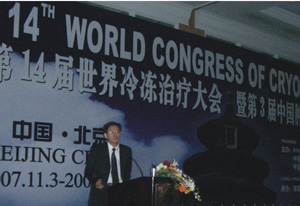
Dr. Niu giving the speech "Experience Percutaneous Cryoablation for 1,300 patient with Lung Cancer"
ENTERING NEW TERRITORY
Cryosurgery is both an ancient and new technique. As early as 3,500 years ago, ice was applied to treat infected leg wounds, bone fracture and various injuries and cuts. However, due to the constraints of technology and equipment, cryosurgery had had its ups-and-downs. In the 1960’s, liquid nitrogen was used to treat liver cancer and prostate cancer. Towards the end of the 20th century, with the approved clinical use of helium-argon ablation technology, cryosurgery started to develop at an amazing rate. China started to develop ablation technique almost at the same time with other developed countries of the world. Besides having performed the most cryosurgery cases, China has made tremendous improvement on ablation techniques. The current emphasis is on the development of percutaneous (through the skin) cryosurgery.
Percutaneous cryosurgery is a minimally invasive therapy. Under the guidance of ultrasound or CT, cryoprobes are inserted percutaneously into tumors and liquid argon under high pressure is passed through the cryoprobes to reduce the temperature to -160 degrees Celsius so that ice crystals are formed to enclose the whole tumor with a margin of safety of 1cm beyond the rim of the tumors. Cancer cells will be killed or destroyed at a temperature of -40 degrees Celsius as a result from the freezing and thawing of tumors in-situ. To accomplish this treatment, the surgeon performing the therapy must have good surgical knowledge and a pair of very skillful steady hands.
Fuda Cancer Hospital introduced cryosurgery early 2001. It was not the first hospital to introduce cryosurgery in China, but how did it become the hospital in China with the largest cases of cryosurgery? “The answer lies in Dr. Lizhi Niu,” said Professor Kecheng Xu, the president of the hospital. “It was not smooth sailing all the way. From March 2001 until March 2002, several specialists had carried out percutaneous cryosurgery but the results were not at all satisfactory. There were a few cases of mishaps. With the arrival of Dr. Niu, things started to change. “From a maximum of 4-5 cryosurgery cases per month, cryosurgery was carried out almost daily and sometime as many as 5-6 cryosurgery operations were performed in a single day. After a span of several years, the number of cryosurgery cases has accumulated to almost 4000.” Professor Xu spoke about the growth and success of Fuda Cancer Hospital passionately.
This author learned that Dr. Niu graduated from the Fourth Army Medical Hospital under the mentorship of Professor Liu Yong Xiu, a renowned cardio-thoracic surgeon in China. Dr. Niu went through a series of stringent fundamental and professional training during his master’s and doctorate studies. After graduation, he worked at the cardio-thoracic department of the affiliated hospital of the Southern Medical University, Guangzhou. He served as a resident doctor and was later promoted as the deputy chief physician. Why did Dr. Niu decide to go into cryosurgery while he was at the peak of his carrier as a cardio-thoracic surgeon?
Dr. Niu replied “Doctors are to provide good services to patients. Fulfilling the needs of patients are doctors’ goals. The daily work of a cardio-thoracic surgeon involves mainly on lung cancer surgery. Only 60-70% of lung tumors are surgically resectable and the recurrent rate after surgery is as high as 50% or more. Worst still, about 80% of patients cannot undergo surgery because by the time they discover that they have tumors in the lung, these tumors have become non-resectable. How to deal with these non-resectable and recurrent tumors? One of the best options would be cryosurgery.”
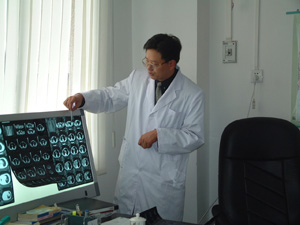
Dr. Niu look at film CT
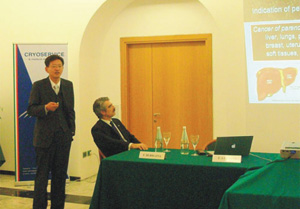
Dr. Lizhi Niu presented a talk on cryosurgery for cancer in Spain
THE ULTIMATE CHALLENGE
Two years ago, at a high level forum on lung cancer in Shanghai, Dr. Niu gave a report entitled “Cryosurgery for Lung Cancer – 800 Cases”. The audience watched in awe when Dr. Niu showed them picture after picture of cryosurgery operations. It was in that forum that Dr. Niu grew to fame from being a relatively unknown doctor. Many medical specialists were amazed to see that under CT guidance, lung tumors, which were closely attached to aorta and heart, were safely treated with cryosurgery. After his presentation, many renowned oncologists congratulated Dr. Niu for his achievements. One of the oncologists commended Dr. Niu for his great courage to carry such prohibitive operations that were akin to extracting teeth from the mouth of a tiger.
Dr. Niu devotes all his time and energy to treat cancer patients that seem to have come to the end of the road. Besides lung cancer and liver cancer, Dr. Niu also applies cryosurgery to eradicate non-resectable tumors or tumors found in areas that are deemed impossible to operate on.
During the 2003 National Day celebration , a cancer patient from Beijing was admitted to Fuda Cancer Hospital-Guangzhou. She was a high school student suffering from cardiac angiosarcoma. This was a very rare type of primary cardiac malignant tumor. There were only 7 reported cases in the world. It normally would lead to heart blockage. She had received operation in Beijing earlier. After operation, her condition improved slightly for a period of two months. On the third month her condition deteriorated. When she came to Guangzhou, her heartbeat was 140 times per minute. Her breathing was rapid, her lips and face turned purple and her jugular vein was not clearly visible. It would be a bit visible at around 2/3 distance from the collar bone to the cheek bone when lying down.
A few days later, a thoracic duct exploration was conducted. It was discovered that there was a dark tumor lining covering the whole heart. By surgery, Dr. Niu cut open the pericardium and performed staggered cryosurgery-freezing the tumor, thawing it and removing it. After operation, the patient’s condition improved. Two months later, she was discharged and went back to Beijing to continue her study. Half a year later, she had a lung infection and died of heart and lung failure. Dr. Niu was very upset over this. He lamented that the patient would be still living if not because of the infection.
Early 2004, another patient with cardiac tumors was admitted into the hospital. She was a 73 years old woman from Hubei. She had similar symptoms as the previous lady student. Because of her old age, heart condition and malignant cancer, hardly any doctor dared to take up her case. Once again, Dr. Niu applied cryosurgery to treat her. After operation, all her tumors disappeared. She came back for check-up three years later and her condition was fine.
The news of Dr. Niu’s Success spread and more and more patients in more severe condition sought Dr. Niu to treat them. Early 2007, an American patient with cardiac tumors flew in all the way from New York after more than 20 hours of traveling to look for Dr. Niu. He had primary lung tumors that were removed three years ago. However, there was a relapse and doctors in the USA predicted that he had at most one more month to live. He brought along more than a hundred CT, MR and PET-CT films. These films indicated that he had tumors that had affected his pericardium, right atrium and right ventricle. His pulmonary vein and superior vena cava were engulfed by tumors. It was impossible to conduct thoracic duct exploration. Under CT guidance, Dr. Niu inserted several cryoprobes into the tumors to freeze them. 125-iodine was also injected locally. It was a tedious process but the result was highly encouraging. A year later, the patient came back for follow-up. The tumors had shrunk to half its original size and acute cardiac blockage syndrome had disappeared. This patient from California conveyed the words of his doctor in the USA, “Don’t ever look down on China!”
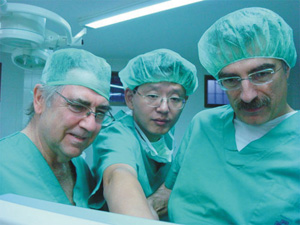
Dr. Niu participating in a cryosurgery with Dr. Franco Lugnani and Dr. Pedro from Spain.
WAR ON KING OF CANCERS
Cryosurgery has been mainly used for treatment of non-resectable tumors. However, is it a substitute for surgery? In Dr. Niu's opinion, it is not a matter of substitution but rather that of combination. In the above-mentioned cases, cryosurgery was performed on the basis of surgery. It widens the scope of surgery and cryosurgery is in fact an extension of surgery.
Pancreatic cancer is considered as “King of Cancer’. Only less than 5% of pancreatic cancer can be operated on. The one-year survival rate of a non-resectable pancreatic cancer patient is less than 10%. Tumors are not removed in cryosurgery but they are destroyed in situ (in place). Hence it is applicable for locally advanced pancreatic cancer. In 2001, Dr. Korpan from Austria proposed cryosurgery to be adopted as a routine treatment for pancreatic cancer. Dr. Niu attempted this issue. He applied cryosurgery on pancreatic cancer patients after caesarean section and discovered further that by CT and ultrasound (endoscopic ultrasound, in particular) guided cryosurgery, the clarity of lesion view was as good as that of operative cryosurgery.
With the goal of reducing the pain experienced by patients, percutaneous cryosurgery becomes the major treatment for pancreatic cancer by Dr. Niu and his team. In his paper on 49 locally advanced pancreatic cancer cases published early this year, 13 cases were by operative cryosurgery and 36 cases by percutaneous cryosurgery. The post-operative one-year survival rate was 53.1%, two-year survival rate 22.8% and three-year survival rate 9.5%. There were 8 patients who have lived for more than two years. One of them who received percutaneous cryosurgery had lived for four years and three months.
Traditional medical community may not believe or do not want to believe in cryosurgery for the treatment of pancreatic cancer, the king of all cancers. Professor Xu, the chief author of the book “Clinical Study of Pancreatic Diseases”, and the president of Fuda Cancer Hospital-Guangzhou cited the 44th ASCO Annual Convention held in Chicago in 3rd June 2008. There were about 20,000 participants but there were merely four papers presented on non-surgical treatment for pancreatic cancer. The first paper was on the effectiveness of gemcitabine as a post-operative supplementary treatment for pancreatic cancer. It was observed the median survival period was extended by 2.6 months. The second paper reported on the limitations of gemcitabine radiotherapy for locally resectable pancreatic cancer. The median survival period was 11 months and 12% for 12 month’s survival period. The third paper was an evaluation of the use of gemcitabine plus two factor-target drugs on metastatic pancreatic cancer. The median survival period was 7.1 months. The fourth paper reported on the effectiveness of combined chemotherapy on gemcitabine-resisting pancreatic cancer. The progression-free survival period was a mere 13 weeks. Professor Xu felt the results quoted were very pessimistic. Though the patients had their survival period extended for a few months, how meaningful was it really to the patients who had to struggle for survival with great suffering from the severe side effects of these drugs?
The fact is academic studies can never take the place of clinical practice. For their survival, patients will not place much importance on the conclusions of academic papers. When Dr. Niu gave live demonstration on cryosurgery and produced proof of his success he had on treating his cancer patients during his medical talks in Europe, it quickly caught the attention of many cancer patients from Europe and America. Pancreatic cancer patients who had returned to Denmark after treatment in Fuda Cancer Hospital also gave their testimonies in newspapers in Denmark on their personal experience in treatment of their pancreatic cancer by cryosurgery. Doctors from the Cancer Society of Denmark also made a special trip to Guangzhou to talk to Dr. Niu and said, “the technique is real and the results are true.” Danish Consul in Guangzhou also made a special call on Professor Xu and expressed that he would recommend to the Danish government to give financial aid to their citizens to receive cancer treatment at Fuda Cancer Hospital. These successful cases, both domestic and foreign, and affirmations from the local medical circle act as a great encouragement to Dr. Niu in his war on the king of cancer and his march towards reaching the summit of medical technology.
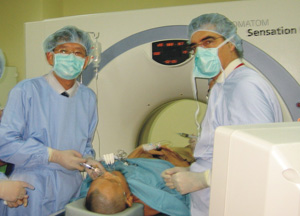
Dr. Niu (left) performing cryosurgical operation for a patient at
an international demonstration witnessed by Dr. Franco Lugnani (right)
A DOCTOR WITH PARENTAL LOVE
Cryosurgery was first approved to be used in the treatment of prostate cancer in the USA back in 1998. It is now being used for the treatment of lung cancer, kidney cancer, mammary gland cancer and uterine cancer and other cancers. The book “Cryosurgery for Cancer” (Shanghai Technology Education Press, 2007), co-authored by Professor Kecheng Xu and Dr. Lizhi Niu, contains references of numerous cryosurgery cases conducted in Fuda Cancer Hospital. How did a hospital of such small scale with a very short history manage to be among the top hospitals in China for cryosurgery.
CCTV had broadcast a documentary called “Save the Elephant Men”. The documentary was about two persons from Malaysia with huge facial tumors who came to Fuda Cancer Hospital-Guangzou for treatment after experiencing difficulties in getting treatment elsewhere. Using cryosurgery as the main treatment, an enormous facial tumor weighing about 5 kg was removed. During the farewell dinner given to these two Malaysian patients who had their facial tumors removed successfully--organized by the Office of Overseas Chinese under the Guangdong Provincial Government--a senior officer was greatly touched and said “This deed of kindness makes me understand thoroughly what a doctor is, and what a doctor with parental love means.”
It is with a parental love at heart that Dr. Niu keeps on improving his techniques. His love for patients enables him to maximize the use of cryosurgery technique to prolong the life span of his patients.
Professor Xu related a story to me. There was an entrepreneur surname Wang from Hong Kong. In 1973 when he was seventy-seven years old, it was discovered that he had liver cancer. He was given liver resection (hepatectomy) in Hong Kong. In 2002, it was discovered there were two tumors in his remaining liver. He did not give in to fate. June 2002, he came to Guangzhou and was admitted into Fuda Cancer Hospital. On the second day there was an overseas call to Professor Xu’s office. The daughter of Wang had looked for him high and low. She requested the hospital to discharge her father immediately. The reason, according to the daughter, was the best doctor in Hong Kong said that her father’s illness was incurable; there was no possibility that doctors in Fuda Cancer Hospital could heal him. On the third day, an email together with a fax message were sent by Wang’s son in the USA saying that he would come to Guangzhou to bring his father back. Mr. Wang said “It is I who is sick. My children have no right to interfere in this matter.” Professor Xu was in a dilemma. At 9.30 p.m. he called for Dr. Niu and showed him the email and the fax message. “Drop the case. Discharge Mr. Wang and let him go.” said Professor Xu. Dr. Niu kept silent for a while and finally said “OK.”. Early the second day morning, Dr. Niu came to Professor Xu’s office and told him ‘Professor, I was unable to fall asleep the whole night. To let Mr. Wang go home means a sure death for him. I believe that cryosurgery should be of help.” “How do we deal with his family members” asked Professor Xu. “By our love and our deed.” answered Dr. Niu with tears in his eyes. “Ok. You go to make the necessary preparations. I will bear all the responsibility.” Professor Xu said. He called for Wang’s son and daughter and led them to the outside of the CT room to observe the whole treatment process conducted by Dr. Niu. Mr. Wang recovered. Several months later, there was the SARS outbreak. Mr. Wang owned a factory producing disinfectants. He donated big quantity of disinfectants to Hong Kong and was crowned by the local media as the King of disinfectants.
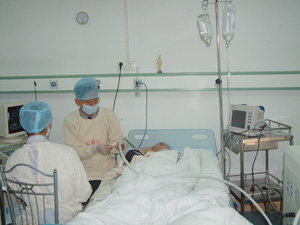
Dr. Niu performing cryosurgical operation for a patient
ALL FOR THE CONTINUATION OF LIFE
How to ensure continuation of life for patients with advanced cancer becomes the main issue. Although in some cryosurgery cases Dr. Niu handled, the tumors could not be completely eradicated but the patients survived. In his paper relating to the more than 800 locally advanced lung cancer cases that he had treated using cryosurgery, Dr. Niu concluded that 20% of the patients lived for more than five years. In 1100 cases of non-resectable lung cancer that were treated with cryosurgery, the three-year survival rate was 61%, and the five-year survival rate was 25%. In fifty cases whereby the tumor size was 10cm, there were twelve cases whereby the patients lived for more than five years. Dr. Niu believes that cryosurgery has dual effects. As a local treatment, cryosurgery can eradicate tumors or reduce the cancer load. On the other hand, tumors remained in situ after cryosurgery has had their cancer cells destroyed, some antigens are released. Some hidden antigens are uncovered, and this stimulates the immune system to produce anti-cancer response. Dr. Niu made a comparison between lung cancer cases treated with surgery and lung cancer cases treated with cryosurgery. It was noted that even though 80% of the tumors were surgically removed, the remaining 20% would grow rapidly. For cryosurgery cases, the remaining tumors would not grow rapidly within a short time. Dr. Niu would remove as much tumors as possible by cryosurgery. If some tumors remain un-resected after initial cryosurgery, the process can be repeated for a second or third time as cryosurgery, unlike surgery, is a minimally invasive treatment; patients can withstand repetitive treatments, which is impossible in the case of conventional surgery.
Dr. Niu showed a PET-CT film of a patient who suffered from cancer of the upper gum with metastatic neck lymph nodes. The patient was given cryosurgery for the upper gum cancer. The PET-CT film taken one month after the treatment showed that the primary tumor had been destroyed by cryosurgery and the metastatic lymphoma had gone, too. In another case, the patient suffered from melanoma with widely spread liver metastasis. Some doctors in Shanghai had predicted that the patient would only have another three months to live. He came to Guangzhou for cryosurgery of the main tumors. Three months later, small tumors within his liver had disappeared, too. He has survived for more than four years.
Several years ago, the World Health Organization (WHO) declared that cancer was a controllable chronic disease. Currently, the cancer treatment model has changed from focusing on the tumors to overall rehabilitation of patients. Cancer is a systemic sickness. The removal of local tumors would not prevent tumor recurrence and metastasis. Cryosurgery has the dual effects of providing both local tumor treatment and a holistic approach to the sickness. Dr. Niu believes that the next step would be combining cryosurgery with immunotherapy as a strategy for the long-term survival of cancer patients.

Dr. Franco Lugnani, President of the International society of Cryosurgery (ISC) presenting
ISC specail Awards for Contributions Towards Cryosurgery Development to Professor Xu (third right), and Professor Niu(second left)